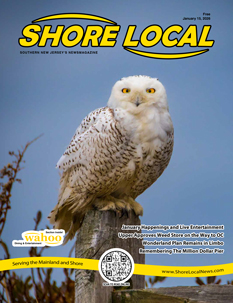By Meteorologist Joe Martucci
Winter is coming. The show “Game of Thrones” made that line famous in its season premiere in 2011.
For New Jersey that is true. On average, October is when we get our first inland freeze of the year. At Atlantic City International Airport, that’s Oct. 23 according to the National Oceanic and Atmospheric Administration (NOAA). Deeper in the Pine Barrens, it’s Oct. 10 (shore folks, you’ll wait until mid-November for your first, on average). If you go way up into northwestern New Jersey, then measurable October snow is in the realm of possibility.
Since 2014, the National Weather Service, a branch of NOAA, has focused on making weather alerts and messaging easier for all of us to understand. A 2018 survey showed that most of us didn’t know what level of danger a winter weather “advisory” meant (85%). To a lesser extent, warnings were confusing, too, like a winter storm warning (57%). An advisory is when a storm is certain, but it does not post a direct threat to life and/or property. Meanwhile, a warning means that a storm is certain and may actually post a direct threat to life and/or property. In other words, the weather community has some work to do.
Part of that is simplifying the number of weather alerts that can be issued. Starting on Oct. 1, the National Weather Service simplified its suite of cold weather products. The goal is to improve messaging about these hazards and provide better decision making. This comes after marine alerts were simplified in 2019 and flood alerts in 2021.
Here’s a look at what you’ll notice, and not notice, as the cold weather season comes upon us.
Extreme Cold Alerts
Before October, there were five different ways to explain to you what type of bitterly cold weather was coming. Now, there are three: Extreme Cold Watch, Extreme Cold Warning and Cold Weather Advisory.
Pre-October, cold weather alerts were broken down by cold due to air temperature vs. cold due to wind chill. The new NWS alerts will allow them to communicate that it’s cold no matter why it’s cold.
Alerts Issued in Our Area
Cold Weather Advisory: Whenever the wind chill or air temperature is expected to be -10 to -24 degrees.
Extreme Cold Watch: Whenever the wind chill or air temperature will possibly be below -25 degrees.
Extreme Cold Warning: Whenever the wind chill or air temperature is expected to be below -25 degrees.
Timing of the Advisories
Typically, your watches will come out 24 to 72 hours ahead of the possible frigid conditions. The advisory and warning will come out within 24 hours of that dangerously cold air.
Don’t expect to see these alerts often, though. According to the Iowa Environmental Mesonet, on average, inland areas of our region experience less than one hour a year below -10 degrees, meeting Cold Weather Advisory Criteria. 2019 was the last time we experienced such cold.
For the Extreme Cold Watch or Warning, below -25, that happens one hour every three years, on average. That hasn’t happened since 1985. At the shore, it’s even less often.
Freeze Alerts
A freeze alert consolidation also took place on Oct. 1. (National Weather Service). We will definitely see freeze alerts in the coming months. Now, instead of four types of alerts, there will be just two: Freeze Watch and Freeze Warning. This change means there won’t be a difference between a hard freeze and a regular freeze anymore.
A hard freeze happens when temperatures drop to 28 degrees or lower for at least one hour. This can kill most fruits, vegetables and plants. A regular freeze occurs when temperatures drop to 32 degrees or lower for the same amount of time. Unprotected plants left outside may get damaged but usually won’t die.
These alerts are only given in the spring and fall. A Freeze Watch or Freeze Warning in spring tells us that the last freeze of the year is coming soon. In autumn, it means the first freeze of the year is on its way, which signals the end of the growing season. We don’t use these during the winter, since the growing season is over.
It’s important to know whether it’s a hard freeze or a regular freeze. The National Weather Service will use stronger words if there is a hard freeze.
In New Jersey, it is rare to have a first or last freeze below 28 degrees. This has happened only 10% of the time at Atlantic City International Airport and the Sen. Frank S. Farley State Marina.
As the first freeze alerts come to our area soon, you’ll see how the National Weather Service is making things simpler. In the future, all alerts will use plain language, which will help us understand important weather information better.
Joe earned his Meteorology Degree from Rutgers University. He is approved by the American Meteorological Society as a Certified Broadcast Meteorologist and Certified Digital Meteorologist, the only one in the state with both. He’s won 10 New Jersey Press Association Awards. You can find him on social media @joemartwx








